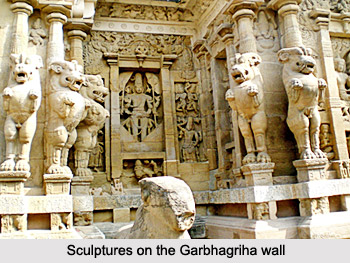 Garbhagriha is also known as the sanctum sanctorum of the temple building. Within the `garbhagriha` the primary idol of the goddess is kept. `Garbhagriha` literally means the `womb chamber.` These rooms closely resemble a cave and are generally etched out of granite. In the temples only the priests are allowed to enter the `garbhagrihas.` It would be wrong to suggest that these architectural structures are found only in Hindu temples. They are also part of the Jain and Buddhist temples.
Garbhagriha is also known as the sanctum sanctorum of the temple building. Within the `garbhagriha` the primary idol of the goddess is kept. `Garbhagriha` literally means the `womb chamber.` These rooms closely resemble a cave and are generally etched out of granite. In the temples only the priests are allowed to enter the `garbhagrihas.` It would be wrong to suggest that these architectural structures are found only in Hindu temples. They are also part of the Jain and Buddhist temples.
The garbhagriha is covered with a well sculpted vimanam. Alongwith the vimanam the garbhagriha constitutes the primary parts of the temples. It is usually known as the main horizontal axis and it is built in the east-west axis. The temples which have a cross axis the garbhagrihas are built at the intersection. These inner chambers are dim lit structures without windows.
In the temples that have been built in the style of Dravidian art and sculpture, the garbhagrihas are often defined as the miniature vimanam. In such temples the outer walls and the outer walls are created together and are known as the pradakshina. The entrance to the garbhagriha is an ornamented one with intricate sculptures. The inner part of the garbhagriha is also well decorated with sculpted figures.
These structures are created on a plinth and are square in shape. The construction of religious temples in India is done according to Vastu Shastra. As a result the place where the garbhagriha is created is considered to be the spot where harmony prevails. Moreover according to the norms of the Hinduism the garbhagriha is considered to be the macrocosm of the universe.



















